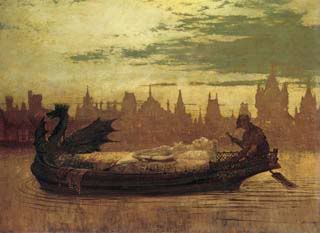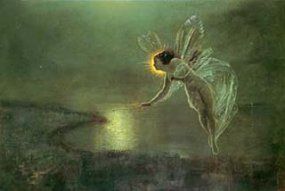 Bruges-la-Morte
Bruges-la-Morte, published in 1892, is possibly the best known work by the Belgian Symbolist writer Georges Rodenbach. The novella concerns a man, Hugues Viane, who has settled in the city of Bruges after the death of his wife. He intends to devote the remainder of his life to a kind of cult of death centred around his deceased wife, and he finds Bruges, which to him seems like a city of the dead, a congenial place in which to do this.
He identifies himself with the city, and comes to feel that he shares its moods and even its soul. He keeps his dead wife’s possessions, and also a lock of her hair preserved under glass. This existence continues until he encounters a woman in the streets, a woman bearing an uncanny resemblance to his wife. This over-sensitive man is prone to obsession at the best of times, and soon becomes obsessed with this woman. She is an actress. They begin an affair. The more he tries to make her fit his image of his departed wife the more he sees that it isn’t quite working, and to add to his problems his obsession is slowly becoming a scandal. Bruges is a very Catholic city, and he starts to fear that perhaps he really is committing a sin and that as a result he may never be re-united with his bride after death. But he has also fallen in love with the actress, although he is perhaps never quite sure which woman it is he is in love with. Of course this situation is not going to end happily.
Hugues’ difficulty in distinguishing between the real woman he once loved, the woman with whom he is now having a affair and the woman of his imagination who is composed of parts of both women is traced with exquisite sensitivity as is his identification with Bruges which becomes both himself and the thing he loves. In his mind death is possibly more real than life.
A wonderful little book. Highly recommended. There are several English translations available; the edition I read was translated by Philip Mosley and published by the University of Scranton Press. It’s also available from Dedalus Books.










 Bruges-la-Morte, published in 1892, is possibly the best known work by the Belgian Symbolist writer Georges Rodenbach. The novella concerns a man, Hugues Viane, who has settled in the city of Bruges after the death of his wife. He intends to devote the remainder of his life to a kind of cult of death centred around his deceased wife, and he finds Bruges, which to him seems like a city of the dead, a congenial place in which to do this.
Bruges-la-Morte, published in 1892, is possibly the best known work by the Belgian Symbolist writer Georges Rodenbach. The novella concerns a man, Hugues Viane, who has settled in the city of Bruges after the death of his wife. He intends to devote the remainder of his life to a kind of cult of death centred around his deceased wife, and he finds Bruges, which to him seems like a city of the dead, a congenial place in which to do this.